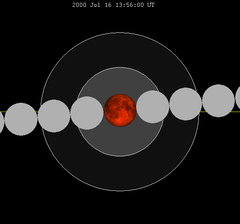|
June 1964 lunar eclipse
A total lunar eclipse occurred at the Moon’s descending node of orbit on Thursday, June 25, 1964,[1] with an umbral magnitude of 1.5565. It was a central lunar eclipse, in which part of the Moon passed through the center of the Earth's shadow. A lunar eclipse occurs when the Moon moves into the Earth's shadow, causing the Moon to be darkened. A total lunar eclipse occurs when the Moon's near side entirely passes into the Earth's umbral shadow. Unlike a solar eclipse, which can only be viewed from a relatively small area of the world, a lunar eclipse may be viewed from anywhere on the night side of Earth. A total lunar eclipse can last up to nearly two hours, while a total solar eclipse lasts only a few minutes at any given place, because the Moon's shadow is smaller. Occurring about 1.5 days after apogee (on June 23, 1964, at 12:30 UTC), the Moon's apparent diameter was smaller.[2] VisibilityThe eclipse was completely visible over much of South America, western Europe, and west, central, and southern Africa, seen rising over much of North America and northwestern South America and setting over much of Europe, northeast Africa, the western half of Asia, and western Australia.[3]
Eclipse detailsShown below is a table displaying details about this particular solar eclipse. It describes various parameters pertaining to this eclipse.[4]
Eclipse seasonThis eclipse is part of an eclipse season, a period, roughly every six months, when eclipses occur. Only two (or occasionally three) eclipse seasons occur each year, and each season lasts about 35 days and repeats just short of six months (173 days) later; thus two full eclipse seasons always occur each year. Either two or three eclipses happen each eclipse season. In the sequence below, each eclipse is separated by a fortnight. The first and last eclipse in this sequence is separated by one synodic month.
Related eclipsesEclipses in 1964
Metonic
Tzolkinex
Half-Saros
Tritos
Lunar Saros 129
Inex
Triad
Lunar eclipses of 1962–1965This eclipse is a member of a semester series. An eclipse in a semester series of lunar eclipses repeats approximately every 177 days and 4 hours (a semester) at alternating nodes of the Moon's orbit.[5] The penumbral lunar eclipses on February 19, 1962 and August 15, 1962 occur in the previous lunar year eclipse set.
Saros 129Lunar saros series 129, repeating every 18 years and 11 days, containing 71 events, has 11 total lunar eclipses. The first total lunar eclipse of this series was on May 24, 1910, and last will be on September 8, 2090. The longest occurrence of this series was on July 16, 2000 when totality lasted 106 minutes and 24.6 seconds.
It last occurred on June 14, 1946 and will next occur on July 6, 1982. This is the 35th member of Lunar Saros 129. The previous event was the June 1946 lunar eclipse. The next event is the July 1982 lunar eclipse. Lunar Saros 129 contains 11 total lunar eclipses between 1910 and 2090. Solar Saros 136 interleaves with this lunar saros with an event occurring every 9 years 5 days alternating between each saros series. Half-Saros cycleA lunar eclipse will be preceded and followed by solar eclipses by 9 years and 5.5 days (a half saros).[6] This lunar eclipse is related to two total solar eclipses of Solar Saros 136.
See alsoNotes
External links
|
||||||||||||||||||||||||||||||||||||||||||||||||||||||||||||||||||||||||||||||||||||||||||||||||||||||||||||||||||||||||||||||||||||||||||||||||||||||||||||||||||||||||||||||||||||||||||||||||||||||||||||||















































